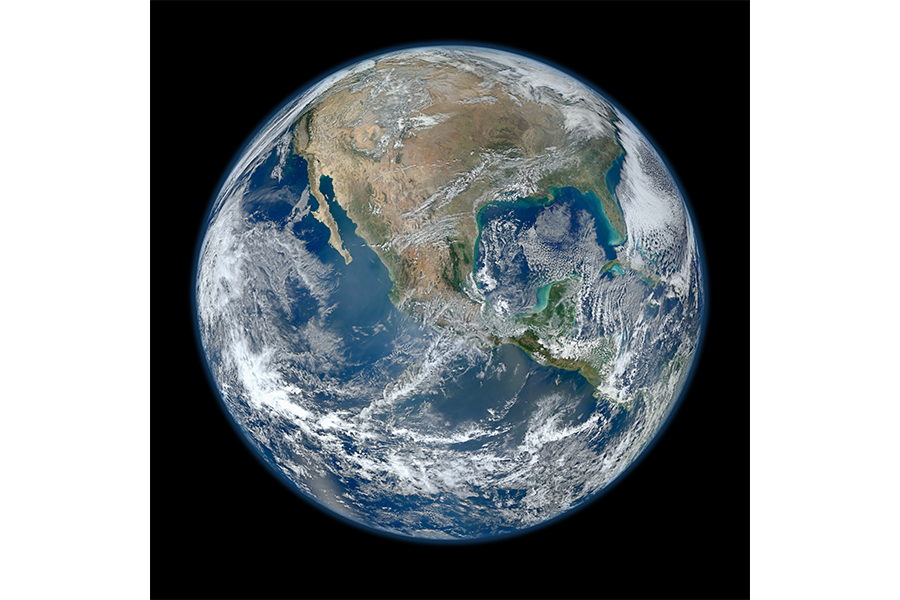Beyond the Blue Marble: How NASA Earth science informs planetary research
Loading...
Since the earliest days of space travel, NASA has looked in two directions: out to space and back toward Earth.
To a public that only knows NASA as the agency that put men on the moon and rovers on Mars, it may come as a surprise to realize how big a role Earth observations have played in NASA programming, and how much that research has informed the exploration of moons and planets in our solar system and beyond.
That connection came into sharp focus on Thursday, when NASA announced the discovery of molecular hydrogen in a plume on Saturn’s moon Enceladus – a discovery that would not have been possible without a robust understanding of environmental systems on Earth.
Nearly all planetary science and exoplanet research has its roots in Earth science, and much of that research has been gleaned from NASA’s Earth science mission, says Marcia McNutt, a geoscientist who has headed the United States Geological Survey, the research journal Science, and the National Academy of Science.
“Had the agency not been studying Earth as a planet,” she adds, “we would not have gained the proper knowledge and perspective for seeking out the signatures potentially conducive to life on other celestial bodies.”
That connection between Earth science and planetary science has many scientists and NASA fans concerned, as President Trump prepares to shift some of the agency’s focus on Earth back toward space.
Planetary science vs. Earth science
Mr. Trump’s proposed budget includes increased funding for astronaut spacecraft and planetary exploration, but makes explicit cuts as well, eliminating four climate-related satellite missions – a proposal that has sparked much criticism from environmental communities. The budget blueprint also includes increased funding for research into the asteroids, moons, and other planets of our solar system, but even planetary scientists are wary of scaling back Earth monitoring.
“Planetary science benefits from this budget – if it stands – but I don't see anybody celebrating,” says Hap McSween, an emeritus professor at the University of Tennessee-Knoxville who has studied meteorites for almost 40 years.
He and his colleagues heard about the blueprint at the March Lunar and Planetary Science Conference in Texas.
“It was really strange,” Professor McSween says. “Even though this was the place where planetary people come, and you'd think they'd be most focused on 'What does NASA's funding portend for planetary explanation?’ … so many of the questions and comments were, ‘We are distressed [by] the de-emphasis of Earth-based science in NASA,’ ” he recalls.
NASA’s Mission to Planet Earth, originally dubbed the Earth Observing System, was initially conceived during the Reagan administration as a component of the International Space Station, but it expanded into a network of free-flying Earth-observing satellites under former President George H. W. Bush that received ongoing funding from Presidents Bill Clinton, George W. Bush, and Barack Obama.
How did NASA evolve from sending humans into orbit to researching the Earth?
It started with the first astronauts, says Ghassem Asrar, whose 20-year career at NASA included serving as deputy administrator for the Science Directorate. “Every time the astronauts went to orbit, they said, ‘It's amazing when we look back!’ ”
They shared their unique view of our planet through their photographs. The now iconic Earthrise and Blue Marble images, taken in 1968 and 1972, seized popular attention just as the environmental movement was taking root.
“Americans suddenly realized that their actions did impact the health of Earth and that changes are happening on a planetary scale,” says Dr. McNutt.
NASA gathers the data that countless other government and private organizations rely on, she says, calling the space agency “a creator of scientific information.”
No obvious successor is poised to take over that “creator” role if NASA's Earth observations are curtailed, says McNutt. Most military data is classified, private organizations rarely release data for free, and while many other nations have space programs, “not all foreign nations agree that data collected with public funds belongs in the public domain, as we do in the United States,” she explains.
Keeping the lights on
While the administration's proposed budget takes a bite out of several climate change observing satellites, it does leave most of the Earth science program intact. Unlike the proposed budgets for the Environmental Protection Agency and the Department of Energy, which included cuts of 31 percent and 20 percent respectively, NASA's funding was reduced by only 0.8 percent in the budget “blueprint” released on March 17. (The final budget will be drafted and approved by Congress later this year.)
In addition to the mission cuts, the proposed budget eliminates the $115 million Office of Education, which provides resources for K-12 teachers and students and also funds scholarships for undergraduate and graduate students. In addition, every mission includes funds for researchers and their student assistants, so mission cancellations can end grad students' careers abruptly.
The renewed emphasis on Europa is a mixed blessing, says Darby Dyar, an astronomy professor at Mount Holyoke College in Massachusetts. “Outer solar system missions have very long time frames. I worry that the pipeline of people who work on missions is going to become pretty leaky as the big missions get farther apart and fewer.”
Stability can be in short supply at NASA, as priorities shift and funding follows. Professor Dyar still remembers the upheaval caused by the transition away from lunar research in the early 1980s.
“Many planetary scientists had coasted along from the remnants of the Apollo program funding, and public interest and pride in lunar exploration,” she recalls. “With Reagan's election, the pendulum looked like it was swinging away from the moon and toward Mars and Venus.”
In some ways, Trump's proposed cancellation of Earth-observing missions is simply another swing of that pendulum. When he signed the NASA authorization bill, one week after releasing the budget blueprint, Trump emphasized an ongoing commitment to astronauts and space science research.
His proposed budget leaves in place the vast majority of the Earth-observing satellites, which have borne inestimable rewards for Americans and the rest of humanity, says Asrar, who enjoys quoting the 1958 National Aeronautics and Space Act that created NASA for “the benefit of all mankind.”
“Going back to the spirit of the Space Act, if we had not included Earth exploration in NASA's mission since inception, would we have today's weather prediction capabilities? Would we have today's space-based telecommunication technologies? Would we have space-based navigation systems today? Probably not,” he says. “But all of those are exactly in the spirit of the Space Act, of serving not only our nation but the entire globe.”








